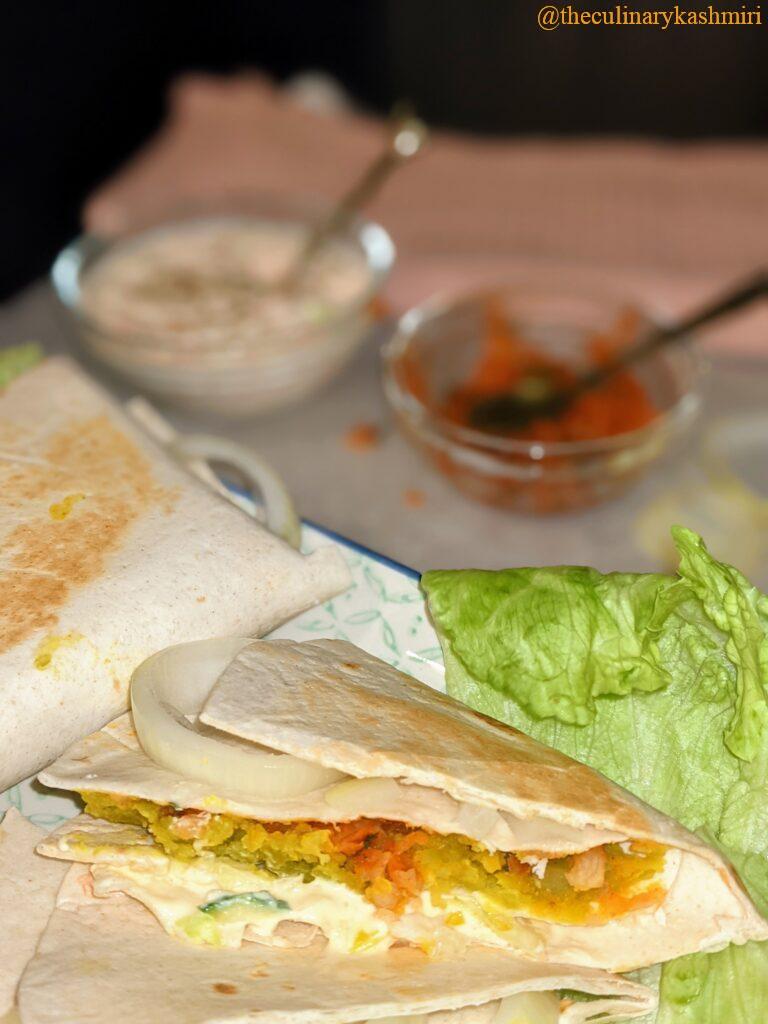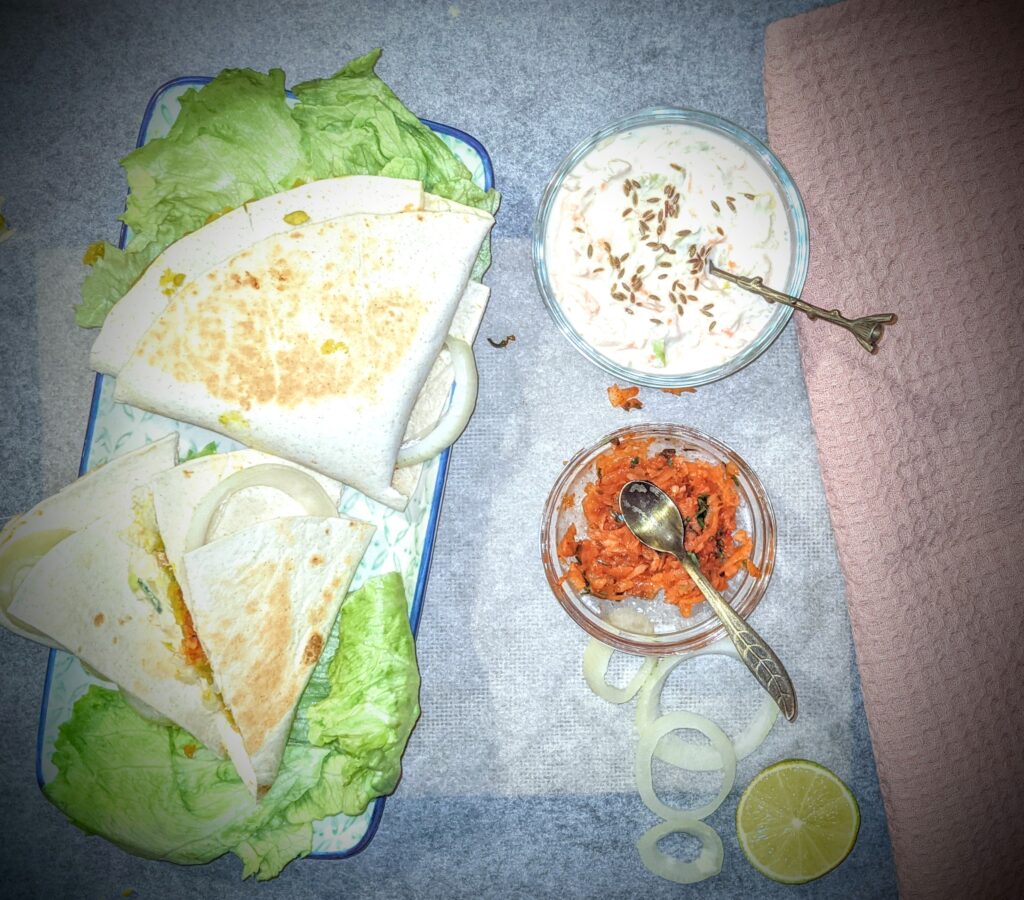Masal’e Tchot- The tiktok tortilla wrap hack

Kashmiri street foods
It is a well established fact that Kashmiri wazwaan and Kashmiri cuisine in general, is envied by food enthusiasts globally. A rather less established fact is that Kashmiri street food is equally enviable. Well, those who are lucky enough to have expanded their culinary horizons beyond the tried and tested Kashmiri cuisine, and not hesitated to taste our street food, would definitely agree.
The street food is on sale in simple push carts or small stalls set up on street corners, especially outside local shrines. Apparently, these may not seem hip, but for sure, these stalls are a haven for foodies. The vendors, who are skilled masters of their art, cook the food in front of the customer. They often boast years of experience in preparing and selling their products.
We have a limited, yet decent variety of street foods. We’re not talking about stale burgers or soggy sandwiches kind of street food. Everything offered by these humble roadside stalls is not just unique, but also clean and prepared in a hygienic manner. To anyone who might be skeptical to try our street foods, I can assure that it is safe to consume, based on years of personal experience.
I always find myself split for choice, tempted by the different kinds of burnt-orange fritters on display, and end up buying a little bit of this and a little bit of that! The most popular ones are nadir monj’e (lotus stem fritters), monj’e gaad’e (fish fritters) and till’e karr’e (pea fritters). Everyone loves these varied offerings, served hot with chutney. In the sweet category, Halw’e poraath is a celebrated street food that leaves your tastebuds craving for more. It is a yellow semolina pudding served on a portion of a fried flatbread, which is amazing because it is about two feet in diameter when seen on display. Other street food delights include khand’e gaazir (battered and fried sweet carrots), tomul laayi (kind of rice pops), gaer gojji (roasted chestnuts) and a few types of masal’e (I’ll come to that in a bit).
We are not restaurant snobs. One of the reasons might be that restaurant culture is relatively new to us. Though times are changing now. If we feel like eating out, we have dozens of options to choose from: from fine dining to fast food, pizzerias and shawarma grills. While all of this is delightful, I just hope that the ranks of our street foods do not get thinned out with time. I hope the legacy of the vibrant street food continues to thrive alongside.
What is Masal’e Tchot?
Masal’e is a generic term for two or three different types of street food, each distinct in terms of ingredients. These include Kenn’k Masal’e, a mix-up of split wheat, corn and sometimes peanuts; Waarri muth masal’e, steamed black beans seasoned with salt and Kashmiri red chilli; and Masal’e tchot, a flatbread stuffed with mushy peas and spicy chutneys.
Masal’e Tchot is different from the other street foods in a number of ways. It is not the greasy kind that attracts all the street food hype. Usually, it is cooked by a hawker who aims to sell it outside schools, colleges and main bus stands in the afternoon. Students and passengers often like to buy one to munch on something and sate their hunger on the long commute home. Why not? It is incredibly cheap, filling and delicious. As I write this, I am imagining myself enjoying a warm and delicious masal’e tchot wrapped in a newspaper, wondering how the hawker manages to keep it steaming hot in his wicker basket, while the chants of “apor lalchowk dalgate runiwor apor batamalyun apor” can be heard in the background.
So, decoding the Masal’e Tchot: It is basically a soft lavasa (naan-like flatbread), stuffed with mushy peas and served hot with a hot radish chutney and raita.

When I first had Fish and Chips with mushy peas in the UK, I knew it right then that I could easily make my own masal’e tchot here. After a little bit of research (because googling counts as research), I found out that I needed dried Marrowfat peas for this venture. I could easily find these in the local super market because apparently the British love mushy peas with fish. The only difference between their mushy peas and our masal’e is turmeric. Adding turmeric gives our masal’e a hint of a yellow colour. This is why people often think that the masal’e is made with chickpeas whereas in reality it is made with dried white peas. That’s the myth-busting for today!
While you’re here, don’t miss out on the recipe for baked fish cutlets to go with the leftover masal’e once you are done making Masal’e Tchot. Also, check out the making of Masal’e Tchot using the Tiktok tortilla wrap hack, on my Instagram reels.

Masal’e Tchot
Ingredients
Masal'e
- 1 cup dried Marrowfat peas
- ½ tsp baking soda
- 1 tsp turmeric powder
- salt to taste
Tortilla wrap
- 8 tortillas
- 1 cup grated radish
- 1 tsp Kashmiri red chilli powder
- ½ cup grated cabbage
- ½ cup grated carrot
- 1 tbsp thick yogurt
- 1 onion
Instructions
Masal'e
- Wash the dried marrowfat peas and place in a large bowl. Add in the baking soda and pour boiling water over the peas, enough to allow room for the peas to double in size. Allow to rest overnight.
- Wash and drain the peas, almost doubled in size. Add in a pot, along with 2-3 cups of water, salt and turmeric. Cook for about an hour on low heat, adding more water if required in between, until the peas can be easily mashed. Alternatively, pressure cook for 15 minutes.
- Allow the extra water to dry out and turn off the heat. Mash the mixture with the help of a fork. Masal'e/ Mushy peas are ready.
Tortilla wrap
- Squeeze and drain off all the liquid from the grated radish. Mix it with 1 tsp of Kashmiri red chilli powder and salt. Mujji tchyot/radish chutney is ready.
- Mix the grated cabbage and carrot with yogurt. Add salt to taste. Raita/coleslaw is ready.
- Slice the onion or cut it into rings.
- To assemble the wrap, spread the masal'e (mushy peas), mujji tchyot (radish chutney), raita (coleslaw) and onion rings or slices, on the tortilla as shown. Alternatively, spread everything on the tortilla and roll it up.
- Toast or grill the wrap and enjoy!
Notes
- Make sure to use Marrowfat peas or dried white peas for this recipe.
- Mushy peas are also available ready-to-eat in canned food sections in supermarkets in UK. Just add a pinch of turmeric and your masal’e is ready.
- Add finely chopped coriander and lemon juice to the mushy peas for a kick of flavour, when having as a side dish.
- Swap the tortilla for a thin naan or lavasa to make a more authentic masal’e tchot.
